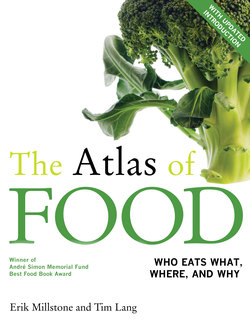Читать книгу The Atlas of Food - Erik Millstone - Страница 8
На сайте Литреса книга снята с продажи.
ОглавлениеInvestigating what we eat, where we eat and how we eat, who goes hungry and why, reveals a remarkable world of contrasting food and drink cultures. These complex but intelligible patterns are what we set out to represent graphically in this atlas. For all the contributors to The Atlas of Food, the modern world of food is not a random series of “facts” or “events”. The food system is an ever-changing web of industrial, technological, economic, social and political factors that impact on the journey food takes from its production on the farm to the eventual consumers. The picture this atlas presents is troubling. It raises some old and some new questions. Why is food such a political problem for humankind? Why have we not managed to feed ourselves well, equitably, healthily, and within environmental limits? Why does the food system keep provoking political, economic and nutritional crises? In 2007 and 2008, after a period of relatively stable or slowly declining food prices since the last great oil and energy crisis in the early 1970s, the price of many staple foodstuffs rose in national markets around the world, provoking unrest in many countries. Over 50 governments imposed price or export controls, adding to instability elsewhere. Some commentators said these problems would be temporary, that higher prices would encourage production and all would be well if only more food were produced. In fact, food prices did drop briefly but then rose again. By late 2012 they had almost matched the peak of 2007 to 2008. The OECD, FAO and most analysts now expect future prices to be volatile and rising, and food security has become a hot political topic one again, not least because of the drought that affected 80 percent of US agricultural land in 2012, and the consequent poor harvest. In truth, the issue of food security never disappeared, though politicians lost interest. For three decades or more, governments assumed that food could best be managed with the application of neo-liberal economic policies. But in an unregulated market, food is consumed not by those who need it most, but by those whose consumption is most profitable to the large agro-business corporations. Instead of the market serving consumers globally, consumers in wealthy countries and communities are increasingly over-consuming unhealthy diets, while poor communities and countries continue to suffer under-nutrition, hunger and starvation. Policy-makers need to guide changes in the ways food is produced, distributed, consumed and wasted, as well as how much is produced, because chronic hunger is not simply a consequence of scarcity; it is a consequence of poverty and powerlessness. Ending global hunger is not just about improving access to, and control of, material resources, but also about poverty, justice, rights and democracy. This wider perspective, linking production and consumption, environment, health and economy, power and distribution, is reflected in this atlas. Attempting to engage with this more complex analysis, some orthodox institutions have proposed including some concern for environmental sustainability in their new push for increasing production as the answer to future problems. The phrase “sustainable intensification” is frequently invoked, though its meaning remains vague and contested. We contend, however, that the problems of the food system cannot be understood merely as problems of production; the perspectives of consumers are at least as relevant as those of producers. We therefore understand the goal of “food security” in far broader terms as encompassing considerations of: sufficiency, sustainability, equitable distribution and safety. Nothing less will do.
Introduction
